Die Redwork-Stickerei hat eine lange Geschichte, die bis ins späte 19. Jahrhundert zurückreicht. It is a simple style of “;art needlework”; in dem die Entwurf ist auf einem weißen oder cremefarbenen Hintergrund mit einer Kontrastfarbe von umrandet Faden. Heutzutage, Dieser Stich wird allgemein als Rückstich oder Umrissstich bezeichnet.
Als dieser Stil populär wurde, Rot Faden war die am einfachsten zu bekommende Farbe. Es war auch farbecht, meaning it would not wash or “;bleed”; auf weißen Stoff. Turkey Red ist der Name eines natürlichen Farbstoffs, der Mitte des 19. Jahrhunderts in Nordamerika populär wurde. Andere Farbstoffe wurden überall verfügbar 1875 und bot eine umfassendere Farbpalette, jedoch, sie würden verblassen. Türkisches Rotgarn war teurer, aber aufgrund seiner Farbe hat es sich gelohnt. Aus 1910 zu 1930, Beliebt war ein gefärbter blauer Faden. Heute, Bei diesem Stickstil verwenden wir weiterhin rotes Garn, da die rote Farbe einen guten Kontrast zum hellen Hintergrund bildet.
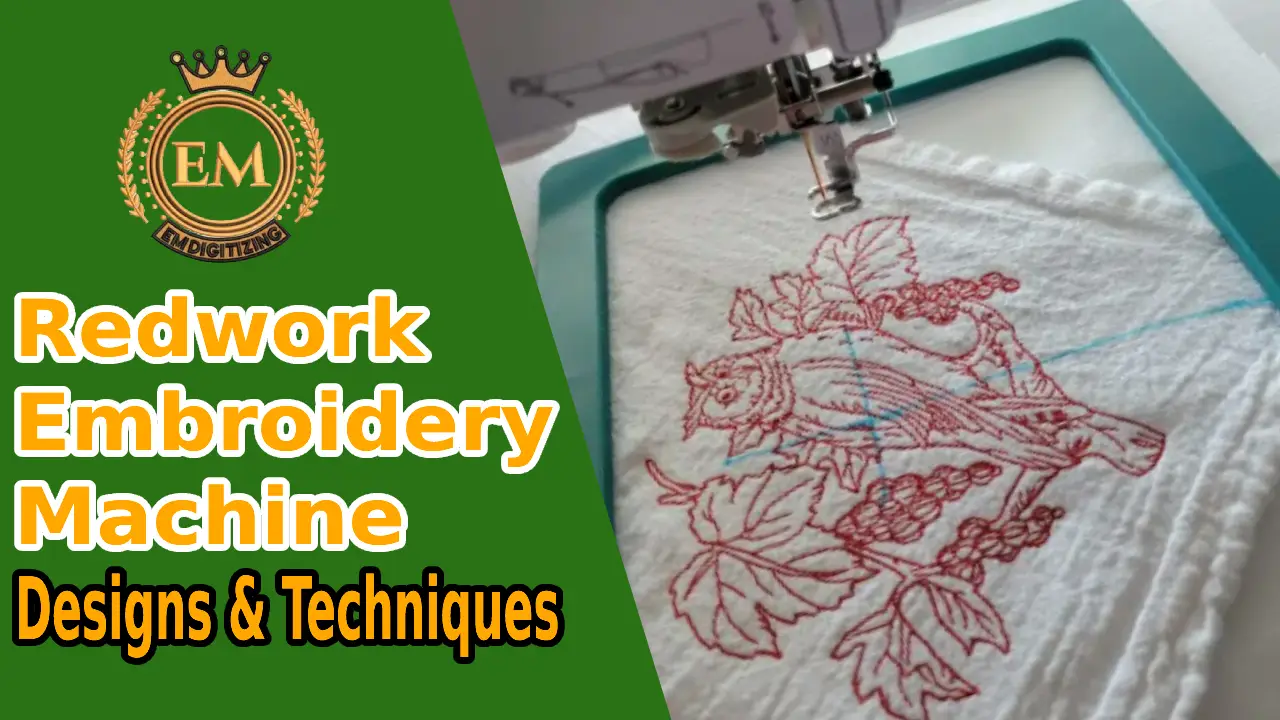
Digitalisierungsdienste für Stickereien
Was ist Redwork-Stickerei??
Redwork-Stickerei ist eine alte Form der Stickerei, die bis ins östliche Europa des frühen 19. Jahrhunderts zurückreicht.
Der Faden war rot gefärbt und war der erste farbige Baumwollfaden, der zum Sticken verwendet wurde, davor gefärbt Faden bestand aus Seide und durfte nur von den Reichen getragen werden.
Diese Art der Stickerei war beliebt, da für die Herstellung weniger Faden benötigt wurde Stickerei-Design. Auch die Entwicklung eines Designs ging sehr schnell vonstatten. Zusätzlich zu diesen Faktoren, Aufgrund der geringen Kosten verbreitete sich die Rotstickerei schnell in andere Teile der Welt.
Welche Stiche verwenden Sie bei der Redwork-Stickerei??
Beim Redwork-Sticken werden nur sehr wenige Stiche verwendet, Das macht es ideal für Stickanfänger. Redwork Stickmotive sind mit wenig oder gar keinen ausgefüllten Bereichen umrandet. Deswegen, Die kostenlosen Redwork-Stickmuster auf dieser Seite sind schnell und einfach zu vervollständigen!
Der Hauptstich der Rotstickerei ist der Stielstich, Er wird auch als Umriss- oder Rückstich bezeichnet. Als Redwork Stickmotive sind skizziert, Dies ist der Stich, der am häufigsten verwendet wird.
Andere Stiche umfassen einen Satinstich, das zum Füllen kleiner Räume in einem Design verwendet wird. Es gibt auch geteilte Nähte, Französische Knoten werden verwendet, um der Rotarbeit-Stickerei kleine Details hinzuzufügen. Auf dieser Seite finden Sie zahlreiche Ressourcen zum Erlernen der Grundstiche für die Rotstickerei!
Redwork-Sticktechnik
Genug mit der Geschichtsstunde! Wie machen wir eigentlich Redwork?? Wegen seiner Einfachheit, redwork ist ein toller Ausgangspunkt für neue Nadelmacher und junge Nadelkünstler. Die fünf Sticharten sind leicht zu erlernen, und Sie folgen einfach den Linien des gedruckten Musters.
- EIN Vorstich taucht den Stoff auf und ab, Erstellen einer Linie wie einer Steppdecke. Das Ziel besteht darin, gleichmäßig verteilte Stiche zu platzieren, um Geschicklichkeit zu demonstrieren.
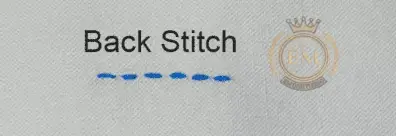 EIN Rückstich ist eine Reihe gleichmäßiger Stiche, Normalerweise wird von rechts nach links gearbeitet, Führen Sie vom letzten Stich aus und dann zurück durch die Öffnung des vorherigen Stichs.
EIN Rückstich ist eine Reihe gleichmäßiger Stiche, Normalerweise wird von rechts nach links gearbeitet, Führen Sie vom letzten Stich aus und dann zurück durch die Öffnung des vorherigen Stichs.
- Das Stammstich arbeitet von links nach rechts. Wieder, mit gleichmäßigen Stichen, diese schachteln sich aneinander, um eine durchgezogene Linie zu bilden. Der Faden wurde unter die Nadel gelegt.

- Das Umrissstich ähnelt dem Stielstich, aber der Faden wird über die Nadel gelegt.
- Das Kensington-Stich ist das, was meine Mutter einen Spaltstich nennen würde. Da kommt die Zahnseide rein 6 Stränge, Sie können verwenden 2, 4, oder 6 Stränge. Die Zahnseide spaltet sich, creating little hearts or “;eyes of the needle.”; Dieser Stich war am schwierigsten zu meistern, da ich die Streifen zählen musste, aber es wird einfacher.
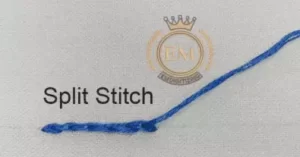
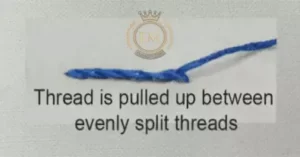
Redwork-Stickmuster
Die meisten Muster waren sehr einfach zu nähen. Tiere, Blumen, Spielzeug, und Kinder sind beliebte Themen. Es wurden auch Bilder berühmter Gebäude und Personen eingenäht, sowie lebhafte Märchenbücher und Kinderreimfiguren. Zeitschriftenverlage stellten Muster zur Verfügung, um für Abonnements zu werben. Als die Ausrüstung leichter verfügbar wurde, manchmal boten sie Bausätze an. Wealthy women used the images as models in children’;s Malbücher und andere Werbung.
Das Stempeln von Stoff – das Übertragen von Motiven auf Stoff – wurde für viele Frauen zu einer Einnahmequelle. Einige Hersteller stellten professionelle Stempeler ein, und einige Frauen erledigten diesen Nebenjob von zu Hause aus. Um 1870, Transfers wurden auf Eisen entwickelt. Die Verwendung eines heißen Bügeleisens war eine einfache Möglichkeit, das aufzutragen Entwurf zum Stoff.
Es wurden vorgedruckte, bestickbare Quadrate verkauft. Ihr tatsächlicher Wert beträgt etwa einen Cent, so they were commonly called “;penny squares”;. Diese Quadrate wurden bestickt und zu Tagesdecken oder Steppdecken zusammengenäht. Zusätzlich, Den Kindern wurden Pfennigquadrate gegeben, um das Handsticken zu erlernen und zu üben.
Redwork-Maschinenstickerei-Designs
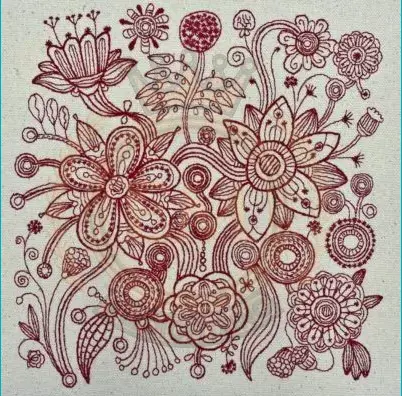
Wie bei jeder Sticktechnik, Nicht alle Stickmotive sind gleich. Bei der Verwendung von Designs auf Ihrem Stickmaschine, Sie möchten sicherstellen, dass sie reibungslos laufen und Ihr Kleidungsstück nicht ruinieren.
Wir empfehlen immer die Verwendung eines Stickerei-Design von dem Sie wissen, dass Sie die besten Ergebnisse erzielen. Emdigitalisieren is sure to always give you the best results as our redwork designs are of the best quality and personally digitized by the world’;Der renommierteste Digitalisierer der Welt.
Mit Hunderten von Redwork-Stickdesigns zur Auswahl, we’;re sure there’;Es ist ein Redwork-Stickdesign, das Ihren kreativen Bedürfnissen entspricht. Sie können viele unserer Emdigitalisierungen ansehen Stickerei-Designs von Klicken Sie hier.
Digitalisierung individueller Redwork-Maschinenstickmotive
Hatch-Sticksoftware verfügt über eine Redwork-Einstellung, die genau zwei Durchgänge ermöglicht, um einen gleichmäßigen Stich traditioneller Redwork zu erzeugen. Ehrlich, it’;Es ist überzeugend, und es bietet die Fähigkeit, mit Übung, zu digitalisieren Handbeschriftung und Reproduktion von Designs.
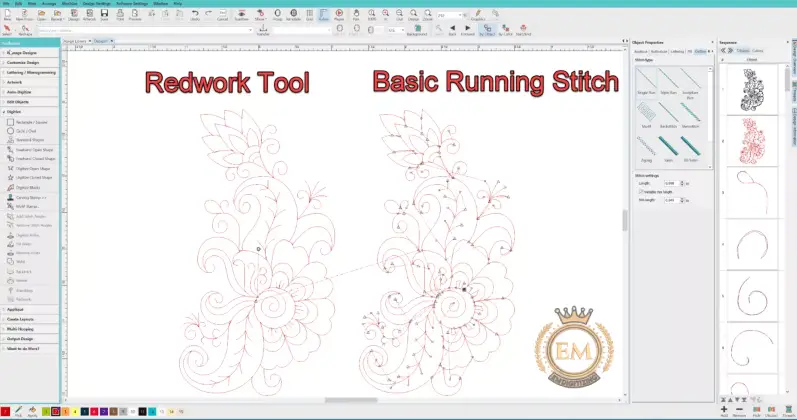
Klingt zu schön, um wahr zu sein? It’;Das ist nicht der Fall, Aber es erfordert, dass Sie ein bisschen wie ein Detektiv sind. Die Redwork muss fachmännisch verlegt werden, damit die Leitungen von einem zum anderen fließen.
Beim Betrachten eines Musters, Sie müssen es herausfinden, bevor Sie anfangen zu springen und zu klicken. Finden Sie Ihren Ablauf heraus und arbeiten Sie von Anfang bis Ende logisch. Sie müssen Ihre Start- und Stopppunkte zusammennähen (grünes Plus und rote Raute) von Mensch zu Mensch, um als Eimerbrigade zu arbeiten.
Ideal, you’;ll digitalisieren das gesamte Muster in einem Durchgang ohne Beschnitt, but if you can’;t (say you’;Wir arbeiten an einem Quiltquadrat mit vier sich wiederholenden Motiven), Stellen Sie dann sicher, dass Sie jeden Teil des Motivflusses starten und stoppen.
Fazit
Hervorragend eignen sich Silhouetten von Kindern oder sorgfältig digitalisierte Bilder von Menschen, wenn auch herausfordernd, Themen. Ganz im Sinne traditioneller Redwork, Verwenden Sie Truthahnrot, Blau, lila, oder grün, und lassen Sie Ihrer Kreativität mit nur einer Farbe freien Lauf.
Now if you want to create redwork but don’;Sie möchten Ihre Designs nicht digitalisieren, don’;Vergessen Sie nicht, vorbeizuschauen Emdigitalisierenist die riesige Sammlung von Standard-Rotarbeiten Stickmotive von Klicken Sie hier.
Redwork or linework is a simple form of “;art needlework”; Dabei wird der Umriss eines Motivs mit rotem Faden oder einer anderen Farbe auf weißen oder cremefarbenen Stoff gestickt, aber es ist normalerweise ein einfarbiges Design. . Ab dem 19. Jahrhundert, Heutzutage wird Rotarbeit allgemein als Rückstich oder Umrissstich bezeichnet.
Der Hauptstich, der bei der Rotarbeit verwendet wird, ist der Rückstich oder Umrissstich, früher als Kensington-Stich bekannt. Rotstickerei war im 19. und 20. Jahrhundert eine übliche Einstiegsform in die Stickerei, die Kindern beigebracht wurde.
Bei den Redwork-Designs handelte es sich um einfache und eher skurrile Strichzeichnungen von Kindern, Vögel, Blumen, eine Wasserpumpe, und andere Gegenstände, die man damals in jedem Haus fand.
Redwork-Quilts, oder Quilts, die aus Umrissstichen mit rotem Faden bestehen, waren im späten 19. und frühen 20. Jahrhundert als Spendendecken beliebt.
Aufgrund der weit verbreiteten Beliebtheit von Redwork heute, Hunderte, vielleicht Tausende, Viele Vintage-Designs wurden zur Verwendung reproduziert. Redwork wurde in den späten 1870er Jahren populär. Der Name leitet sich vom Stickgarn Turkey Red ab.
